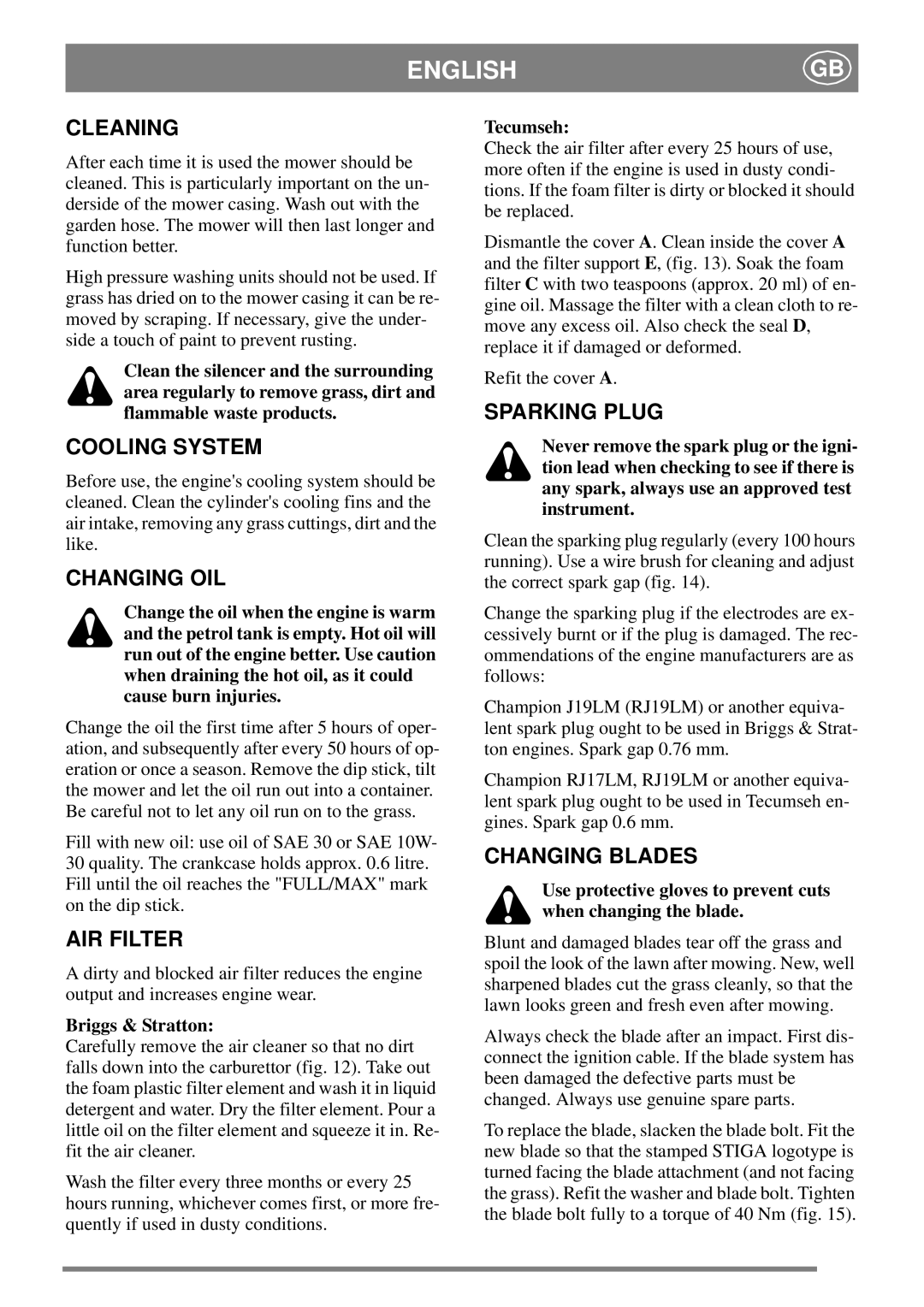
ENGLISH | GB |
|
|
CLEANING
After each time it is used the mower should be cleaned. This is particularly important on the un- derside of the mower casing. Wash out with the garden hose. The mower will then last longer and function better.
High pressure washing units should not be used. If grass has dried on to the mower casing it can be re- moved by scraping. If necessary, give the under- side a touch of paint to prevent rusting.
Clean the silencer and the surrounding area regularly to remove grass, dirt and flammable waste products.
COOLING SYSTEM
Before use, the engine's cooling system should be cleaned. Clean the cylinder's cooling fins and the air intake, removing any grass cuttings, dirt and the like.
CHANGING OIL
Change the oil when the engine is warm and the petrol tank is empty. Hot oil will run out of the engine better. Use caution when draining the hot oil, as it could cause burn injuries.
Change the oil the first time after 5 hours of oper- ation, and subsequently after every 50 hours of op- eration or once a season. Remove the dip stick, tilt the mower and let the oil run out into a container. Be careful not to let any oil run on to the grass.
Fill with new oil: use oil of SAE 30 or SAE 10W- 30 quality. The crankcase holds approx. 0.6 litre. Fill until the oil reaches the "FULL/MAX" mark on the dip stick.
AIR FILTER
A dirty and blocked air filter reduces the engine output and increases engine wear.
Briggs & Stratton:
Carefully remove the air cleaner so that no dirt falls down into the carburettor (fig. 12). Take out the foam plastic filter element and wash it in liquid detergent and water. Dry the filter element. Pour a little oil on the filter element and squeeze it in. Re- fit the air cleaner.
Wash the filter every three months or every 25 hours running, whichever comes first, or more fre- quently if used in dusty conditions.
Tecumseh:
Check the air filter after every 25 hours of use, more often if the engine is used in dusty condi- tions. If the foam filter is dirty or blocked it should be replaced.
Dismantle the cover A. Clean inside the cover A and the filter support E, (fig. 13). Soak the foam filter C with two teaspoons (approx. 20 ml) of en- gine oil. Massage the filter with a clean cloth to re- move any excess oil. Also check the seal D, replace it if damaged or deformed.
Refit the cover A.
SPARKING PLUG
Never remove the spark plug or the igni- tion lead when checking to see if there is any spark, always use an approved test instrument.
Clean the sparking plug regularly (every 100 hours running). Use a wire brush for cleaning and adjust the correct spark gap (fig. 14).
Change the sparking plug if the electrodes are ex- cessively burnt or if the plug is damaged. The rec- ommendations of the engine manufacturers are as follows:
Champion J19LM (RJ19LM) or another equiva- lent spark plug ought to be used in Briggs & Strat- ton engines. Spark gap 0.76 mm.
Champion RJ17LM, RJ19LM or another equiva- lent spark plug ought to be used in Tecumseh en- gines. Spark gap 0.6 mm.
CHANGING BLADES
Use protective gloves to prevent cuts when changing the blade.
Blunt and damaged blades tear off the grass and spoil the look of the lawn after mowing. New, well sharpened blades cut the grass cleanly, so that the lawn looks green and fresh even after mowing.
Always check the blade after an impact. First dis- connect the ignition cable. If the blade system has been damaged the defective parts must be changed. Always use genuine spare parts.
To replace the blade, slacken the blade bolt. Fit the new blade so that the stamped STIGA logotype is turned facing the blade attachment (and not facing the grass). Refit the washer and blade bolt. Tighten the blade bolt fully to a torque of 40 Nm (fig. 15).
